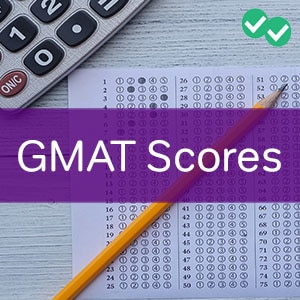
Your GMAT score is a key component of your application when applying to business school—but how do you know if your score is “good”? The answer depends on several factors, including your target schools, your academic and professional background, and your overall application.
There’s no single magic number that guarantees admission, but there are score ranges that can make your application more competitive. Whether you’re aiming for a top-10 MBA program or a strong regional school, understanding what counts as a good GMAT score will help you set realistic goals and plan your study strategy effectively.
In this guide, we’ll walk you through:
- How GMAT scores are structured
- What different score ranges mean for both the current GMAT and the old, legacy GMAT
- How to evaluate your score based on your goals
- Tips for deciding what your target score should be
Takeaway: A “good” GMAT score is the one that gets you into your program of choice. But a common reference point is that a 615 on the current GMAT (which is a 650 on the old GMAT) is a very good score.
Understanding the GMAT Scoring System
Before we can figure out what a good GMAT score looks like, it helps to understand how the test is scored—especially now that there are two versions commonly discussed: the present-day GMAT (also called the GMAT Focus Edition) and the older, legacy version of the GMAT (or “Classic GMAT”).
Total GMAT Score Range
- Present-day GMAT: 205 to 805 is the total score range for the current version of the exam (launched in late 2023)
- Classic GMAT: 200 to 800 is the range for the older version of the exam.
Why is it important to know this? Because a lot of business schools still list Classic GMAT scores on their websites. And it will still be a couple years before they fully switch over to providing average scores or middle-80-percent score ranges for the present-day GMAT.
Section Scores
The GMAT Focus Edition consists of three sections:
- Quantitative Reasoning
- Verbal Reasoning
- Data Insights
Each section is scored from 60 to 90, and all three contribute equally to your total score. There is no essay (Analytical Writing Assessment) in the current version of the GMAT, nor a separately scored Integrated Reasoning section like on the Classic GMAT.
What Do Percentiles Mean?
Along with your score, you’ll receive a GMAT percentile ranking, which tells you how your performance compares to other test-takers. For example, a score in the 90th percentile means you scored higher than 90% of everyone else who took the test.
This can be incredibly helpful for putting your score in context. A 645 out of a total 805 points might not sound like much until you realize it puts you in the top 15% of test-takers. On the flip side, even a seemingly high score may not be enough if your target schools are especially competitive.
💡 Percentiles also allow for score conversion between Classic GMAT scores and GMAT Focus scores.
What’s Considered a Good GMAT Score?
So, what does a “good” GMAT score actually look like? The truth is, it depends on your goals. A good score for one student might be average or even low for another, depending on where they’re applying and what the rest of their application looks like. That said, we can break down general score ranges that are considered strong across the board, whether for the current or old GMAT:
| Competitiveness | Current GMAT Score | Percentile | Legacy GMAT Score |
|---|---|---|---|
| Average | 555 | 49 | 580 |
| Above Average | 565+ | 52+ | 600+ |
| Good | 595+ | 66+ | 640+ |
| Very Good | 615+ | 75+ | 650+ |
| Great | 645+ | 85+ | 690+ |
| Excellent | 655+ | 90+ | 700+ |
| Fantastic | 675+ | 95+ | 720+ |
Now, what do those score competitiveness labels mean?
- Above Average (565+): Though a score here puts you ahead of most test-takers, it’s generally not that competitive. However, it may be sufficient for your particular target schools.
- Good (595+): A score in this range will keep you in the running for many MBA programs, especially those outside the top 50.
- Very Good (615+): A score here puts you in the top 25% of test takers, which is typically good enough for many of the top business schools ranked between 30th and 50th.
- Great (645+): Achieving this score is competitive for the upper bound of the top 25 business schools.
- Excellent (655+): At this point, you have a competitive score for just about any program in the top 20, including Johnson, Anderson, and Goizueta.
- Fantastic (675+): This is the sweet spot for the top-10 MBA programs, such as Wharton, Kellogg, and Booth.
💡 Use your score as a signal. If it’s well above your target school’s average, it strengthens your case. If it’s below, the rest of your application will need to shine even brighter.
How Your Target Schools Impact What’s “Good”
No matter how high your GMAT score is, it only matters in context—especially the context of your target business schools. A “good” score for one MBA program might be just average—or even below average—for another. That’s why researching the schools on your list is essential.
Top-Tier MBA Programs
Highly selective programs like Stanford, Harvard, Wharton, Booth, and MIT Sloan typically report average GMAT scores in the 675-685 range on the Focus Edition, or 720–740 on the Classic GMAT. To stay competitive at these schools, you’ll often want to be at or above those averages.
Keep in mind: top schools also receive thousands of high-scoring applications, so a strong GMAT score alone may not guarantee admission—but a low score could be a dealbreaker.
Mid-Tier and Regional Programs
For solid MBA programs outside the top 20 or top 50, average scores are usually lower. Many excellent schools accept students with scores in the 605-645 range.
If you’re applying to programs that prioritize professional experience or local industry ties, your score might matter less, especially if other parts of your application are strong.
Always Check Class Profiles to Determine What’s a Good GMAT Score for You
Most MBA programs publish average GMAT scores on their admissions websites or class profile pages. Look for:
- Average or median GMAT scores
- Middle 80% GMAT ranges
- Breakdown of average scores for domestic vs. international students
These insights help you gauge whether your score aligns with your target programs—or if you might need to retest to stay competitive.
And, again, keep in mind that most schools are still reporting Classic GMAT scores. To convert those to current GMAT scores, use a GMAT score conversion chart.
❗ Did you know that almost all business schools accept GRE scores, too? If your GMAT score isn’t where you want it to be, consider whether the GRE might be a better fit for you.
Other Factors That Influence Your Target GMAT Score
While your GMAT score is a critical part of your MBA application, it is ultimately one datapoint. Admissions committees evaluate candidates holistically, which means your ideal target score also depends on who you are and what your broader application looks like.
Your Professional and Demographic Background
If you’re from an overrepresented applicant pool—such as finance professionals, engineers, or consultants—especially from countries like India or China, you may need a higher GMAT score to stand out. That’s because schools receive a large volume of similar applications, so every element (including your test score) needs to rise above the average.
On the other hand, candidates from underrepresented backgrounds may be competitive with slightly lower scores, especially if they bring unique professional experiences or perspectives to the cohort.
Your Overall Application Strength
Admissions committees don’t make decisions based on test scores alone. A slightly lower GMAT score can be offset by:
- Exceptional work experience
- A strong academic record (especially in quantitative courses)
- Powerful essays and recommendations
- Clear and compelling career goals
If your application tells a cohesive and impressive story, you don’t need to hit the very top of the score range to get in. Therefore, never view your GMAT score in isolation—view it as part of your bigger application narrative.
Your Career Goals
Your post-MBA goals can also shape what GMAT score you should aim for. For example:
- Want to break into consulting or investment banking? A higher score may be helpful since top firms often value strong academic indicators.
- Interested in entrepreneurship, non-profit leadership, or social impact? Schools may prioritize your vision and experience over your test score.
Tailor your score target based on the demands of your intended industry and how important academic benchmarks are in that space.
💡 Want to know more about what Admissions Committees are specifically looking for? Watch our GradTalk interviews on YouTube.
Score Balance Across Sections: Why It Matters
While your total GMAT score gets the most attention, don’t underestimate the importance of your section scores—especially if you’re applying to competitive MBA programs.
Why Schools Look Beyond Your Total GMAT Score
MBA programs are rigorous and quantitatively demanding. Admissions committees want to make sure you’re prepared to succeed in all areas of the curriculum—not just one. That’s why they look at your Quantitative, Verbal, and Data Insights scores individually to check for a well-rounded skillset.
A lopsided score—say, an 87 in Verbal but a 70 in Quant—might raise questions, especially if you don’t showcase a strong quantitative background elsewhere in your application.
Quantitative Reasoning: A Common Focal Point
For many applicants, the Quant section carries a bit more weight, particularly if:
- You didn’t major in a quantitative field (for example: humanities, liberal arts)
- You don’t use math regularly in your job
- You’re applying to finance, consulting, or data-heavy MBA tracks
A strong Quant score helps show that you can handle the mathematical prowess that business school demands.
Verbal and Data Insights Matter, Too
With that said, don’t neglect the other two sections!
- Verbal Reasoning: Strong scores here demonstrate your ability to comprehend complex texts, build logical arguments, and communicate clearly—skills essential for leadership and collaboration.
- Data Insights: This section tests your ability to interpret data from charts, tables, and graphs. It’s a good indicator of how you’ll handle real-world decision-making in a data-driven business environment.
💡 Curious how the different section scores add up to the total score? Check out our GMAT Score Calculator as well as our interactive GMAT Score Chart to see what section scores you need to achieve your overall target score goal.
How to Set Your GMAT Score Goal
Now that you understand what a good GMAT score looks like across different contexts, it’s time to figure out what a good score looks like for you. Setting a target score is a crucial step in your prep journey—it gives you direction, structure, and motivation.
Here’s how to set a smart, personalized GMAT score goal in five steps:
1. Research Your Target Schools
Start by identifying the average GMAT scores of recently admitted students at the programs you’re applying to. You can usually find this info on each school’s:
- Admissions website
- Class profile page
- MBA rankings breakdown (e.g., U.S. News, Financial Times)
For example, if your dream school reports an average GMAT score of 675, your goal should be at or above that.
2. Check the GMAT Score Range, Not Just the Average
Many programs also list the middle 80% range of admitted students. This tells you the lower and upper bounds of what they typically accept. If your score falls within or above that range, you’re likely in a strong position.
3. Evaluate Your Strengths and Weaknesses
Be honest about your academic and professional background:
- Are you a strong test-taker?
- Do you have sufficient quantitative experience in your resume?
- Is your undergraduate GPA on the weaker side?
If you’re compensating for other weaknesses in your profile, aim for a score that’s above average for your target schools to boost your odds.
4. Plan for a Buffer
Test day doesn’t always go perfectly. Thus, add a 10–20 point buffer to your goal score in case:
- your actual test score ends up slightly below your practice test average
- you want the option to apply to more selective schools later
5. Set a Realistic but Ambitious GMAT Score Target
Use all this information to land on a number that pushes you just enough outside your comfort zone—something that’s achievable with focused prep, but high enough to open doors.
For most students, that sweet spot is between 595 and 645+, depending on the schools they’re targeting.
Once your goal is set, it becomes your anchor: the number you aim for on practice tests, the benchmark to track your progress, and the finish line for your study plan.
💡 Speaking of practice tests, take a free full-length GMAT online to get an estimated score to use as a baseline for your prep.
Closing Thoughts on GMAT Scores
At the end of the day, a good GMAT score is the one that helps you achieve your goals.
For some students, that might mean hitting a 675+ to stay competitive at a top-10 school. For others, a 615 might be the key to unlocking a high-value regional MBA that’s perfect for their career path.
What matters most is understanding where you stand—and where you want to go. By researching your target programs, setting a realistic and strategic goal, and staying committed to your study plan, you can put yourself in a strong position for success.
Remember:
- Your GMAT score is important, but not everything.
- Admissions committees consider your entire application.
- Even a slightly below-average score can be overcome with strong work experience, academics, and essays.
So take a deep breath, map out your prep, and keep your eyes on your personal goal. And to help achieve it, consider a Magoosh GMAT Premium plan. We offer over 800 practice questions and 200 video lessons to cover everything you need to know for the GMAT.





